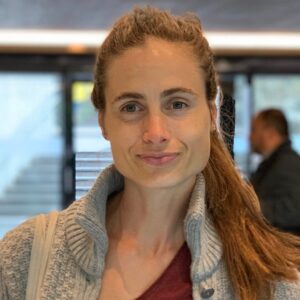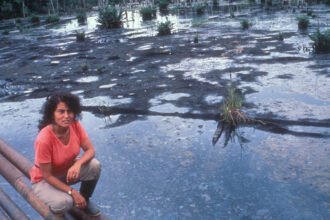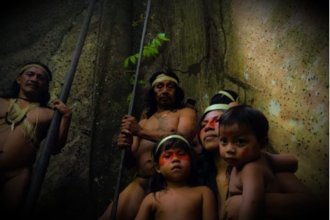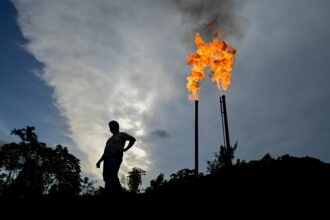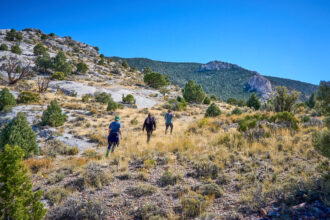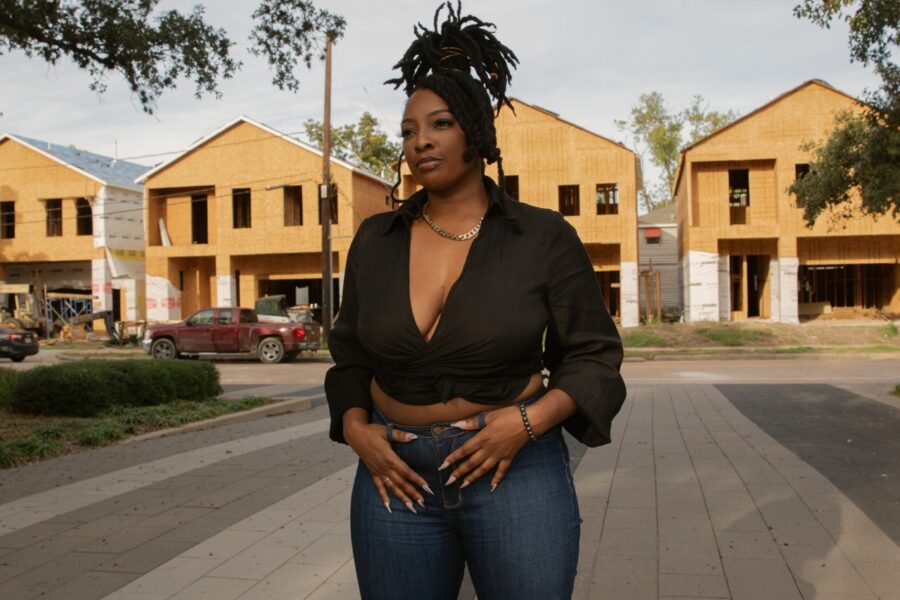The Education of Judith Kimerling: An American lawyer’s epic struggle to stop expanding oil operations harming Indigenous peoples in Ecuador’s Amazon. Part two.
In the early 2000s, Judith Kimerling moved naturally between teaching law and political science at the City University of New York’s Queens College and her work in Ecuador. During summer and winter breaks, she’d fly to Ecuador, descending past the snowcapped Andes mountains enveloping Quito.
She’d been working in Ecuador to help locals protect their rainforest since publication of her acclaimed 1991 book, Amazon Crude, in which she revealed the devastation wrought by oil exploration in the Ecuadorian Amazon.
Returning to New York, she would peer out at the Manhattan skyline, and inside her classroom at CUNY, the noted environmental activist and Indigenous rights lawyer devised exam questions varying on a hypothetical: should citizens of other countries be allowed to sue American multinational corporations in U.S. courts for harms those companies allegedly cause abroad? For her, it was not a rhetorical question.
[Read Part One of the Education of Judith Kimerling]
In 2002, a federal judge in New York dismissed a class action lawsuit against Texaco over the company’s environmentally devastating operations in Ecuador. Cristobol Bonifaz, an Ecuadorian attorney living in the United States, had been inspired by Kimerling’s book to file that suit in 1993. But nearly a decade later, a U.S. judge ruled that Ecuador was the more appropriate forum to try the case and declared that the dispute “has nothing to do with the United States.”
Kimerling’s disappointment with how courts and other players in the justice systems treat Indigenous communities only grew in the coming years.
In May 2003, Bonifaz and a legal team he assembled filed a new lawsuit against Chevron (which had acquired Texaco) in an Ecuadorian court in the oil town of Lago Agrio.
Shortly after, Bonifaz and another senior attorney left the legal team and a junior member of their group, American lawyer Steven Donziger, became the figurehead of the case. Bonifaz, who comes from a prominent Ecuadorian family, told me that at this juncture, he feared the case would become vulnerable in the notoriously corrupt Ecuadorian judicial system. Kimerling, too, was concerned about the new suit against Chevron. Her unease over the lawyers’ engagement, or lack thereof, with Indigenous and other people affected by Texaco had only solidified over the past decade.
Some of them regularly sought out Kimerling for information about the case.
In 2005, she was invited to attend a gathering of Indigenous groups in Coca for that reason. There, Kimerling unexpectedly ran into Penti Baihua, a recently contacted Waorani Indigenous man. He remembered Kimerling from her visit to his home in a remote region of the rainforest in the 1990s. When the gathering wrapped up he asked her to visit Bameno once more and to talk with his community about how they and other Waorani groups were continuing to lose territory to oil operations and colonists who settled along oil roads. Kimerling accepted his invitation knowing that those weren’t the only threats to Waorani groups.
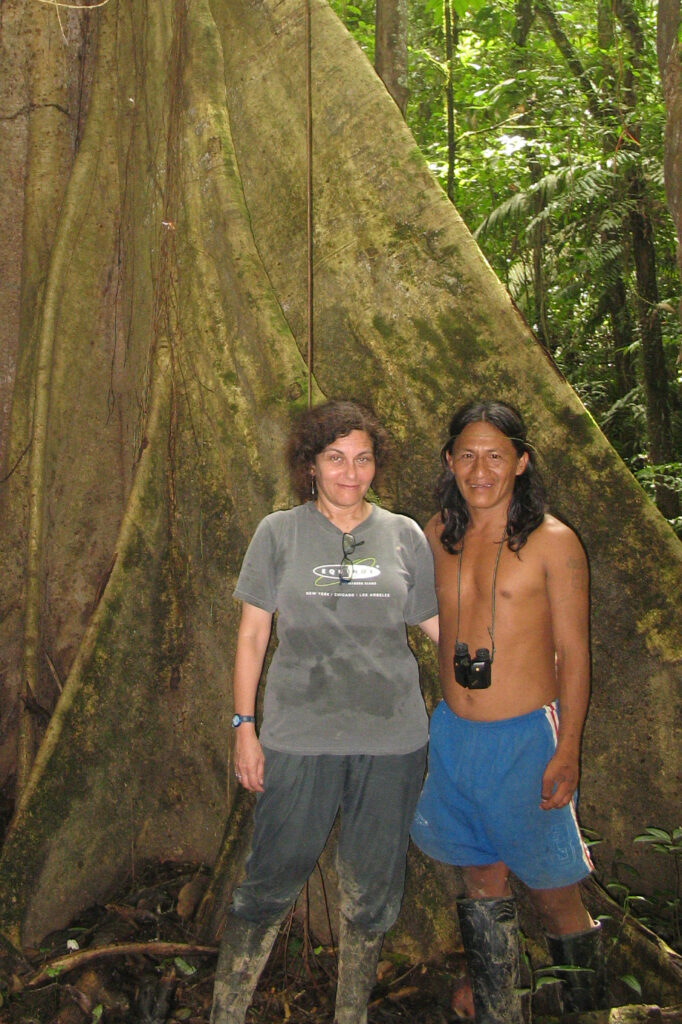
Though Penti had not yet mentioned it, she had heard about violence between illegal loggers and uncontacted Waorani families.There are three remaining in Ecuador, the Tagaeri, Taromenane and Dugakeri. In 2003, a massacre of more than two dozen Tagaeri or Taramonae people was widely reported in the Ecuadorian press. On the boat ride into the forest with Penti, Kimerling saw for the first time felled trees on the river left by illegal loggers operating openly in the rainforest.
Penti told her how he had twice visited officials in Coca, asking them to remove the loggers, but because the government had failed to take meaningful action, he was beginning to organize with other Waorani communities to evict the armed intruders.
He also spoke about how oil companies were moving operations closer to the territory of his family, the Baihuaeri, a recently contacted clan of Waorani who have maintained their traditional culture and who share some territory with uncontacted groups. He wanted to protect his family’s forest for future generations but knew that he could no longer defend it with spears, the way his father and grandparents had. Now, he was trying to find new methods like speaking Spanish, using documents and working with outsiders.
Kimerling spent most of the conversation, and her visit, listening. If she was going to help the Baihuaeri, she needed to understand them, and that would take time. She did, however, tell him that there was growing pressure on the government to remove the loggers and offered one piece of advice before leaving.
“It’s important that you all are talking about working together to get rid of the loggers,” she remembers telling Penti. “If you don’t do it, the government will come in and they won’t leave.”
The Other End of the Spear
Kimerling continued visiting Bameno at least twice a year, and with each visit her relationship with the Baihuaeri deepened.
During a sabbatical year from CUNY in 2006, she stayed in Bameno for a month, bringing with her a stack of books written by missionaries about the Waorani. American missionaries with the Summer Institute of Linguistics were responsible for first forcing contact on the Waorani in 1958 to evangelize them and later worked with, and were aided by, Texaco to pacify and clear Waorani from oil rich areas. The missionaries’ books drew interest from the community, and Kimerling began telling them what the missionaries had written in English and Spanish and asking if it was true. The group would then explain why so much of what the missionaries had written was false, or at best, misleading. “I wanted to understand the ‘other end of the spear,’” Kimerling told me about that era, referring to a missionary book entitled the “End of the Spear.” The books said that the Waorani had a “warped culture of hate and fear,” that they were the “most savage culture ever known” and were “untamed.”
To create a record of the Baihuaeri’s history in their own words, she began videotaping interviews with Baihuaeri elders, asking them about their experiences before, during and after forced contact. Penti’s father, who has since passed away, talked of defending their territory from oil companies with spears. People told Kimerling about how they had barely survived the rubber boom and how family members had been abducted by rubber trappers. They talked about their relationships with their forest and how the women made the decisions about where and what crops to cultivate. Penti shared how the harpy eagle goes far from its nest to hunt so that when its babies hatch, they can hunt animals closer to the nest—now, he told Kimerling, he has to be like the harpy eagle and travel far to protect his territory.
From these interviews and other conversations, she learned that each Waorani clan has its own ancestral territory and considered all non-Waorani people as cowode, or strangers, and all other Waorani clans as “others.” She learned that there were some overlapping, shared trails, hunting grounds and customs, like leaving a crown of palm to indicate that one group meant no harm to another. And she watched as Penti’s uncle, a renowned “Jaguar Shaman” named Kemperi, slipped at dusk into the realm of the spirit of the jaguar.
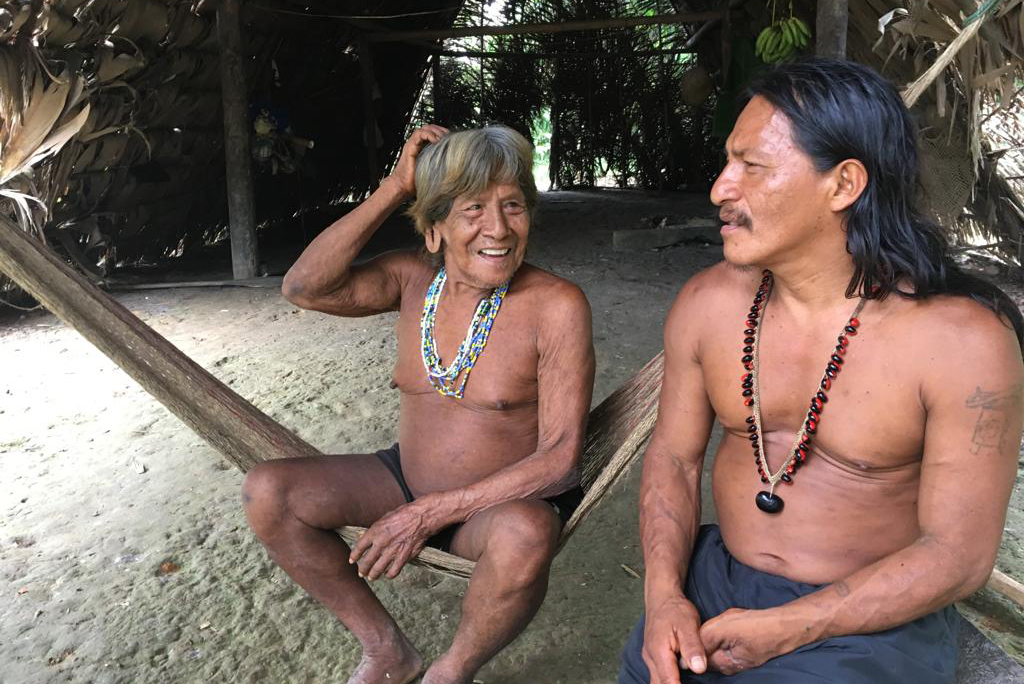
From his hammock, the jaguar spirit spoke through Kemperi to the community, chanting, curing medical ailments and answering questions about the forest and its human and nonhuman inhabitants. When I asked Kimerling what she made of this she told me: “It’s very real, it’s very powerful and important to their culture. I accept that I can’t fully understand it.” Once, Penti and Kemperi took her on a long trek through the forest on an ancient Waorani trail. She couldn’t read nature like the Waorani could, and when she lost the path, she felt a tap on her shoulder and turned to see Kemperi’s incandescent smile as he reoriented her in the right direction.
After spending long periods of time in Bameno, Kimerling, upon arriving in Coca, was hit with waves of sensory overload. It was as if she could feel all of the frenzied energy and activity of the city in her bones. The forest had been so peaceful and suddenly it felt like her body was being assaulted by noises and smells that she had never noticed before. It made her wonder what it must be like for the Baihuaeri when they come into the city, a world they considered foreign from their own.
Although she had long advocated for Indigenous peoples, Kimerling’s time with the Baihuaeri reinforced and intensified her understanding that one thing, above all else, was paramount to ensuring their physical and cultural survival—they needed secure legal rights over their land. As she saw it, there was one problem standing in their way: too many others wanted to control it.
The Intangible Zone
About a year after Kimerling began making regular visits to Bameno, reports reached Quito of more violence involving illegal loggers and uncontacted Waorani family groups, culminating in an April 2006 massacre of a family group of Tagaeri or Taromenane.
On May 4, 2006, three activists filed a petition before the Inter-American Commission on Human Rights, alleging that the Ecuadorian government was responsible for violations of the rights of the Tagaeri and Taromenane. Based in Washington D.C., the commission is an independent arm of the Organization of American States with a mandate to help governments keep their human rights commitments.
The activists asked the commission to order the Ecuadorian government to take what is known as “precautionary measures” to prevent further violations of the rights of the Tagaeri and Taromenane.
When Kimerling first heard through friends about the activists’ petition, she felt a sense of déjà vu. As with the Texaco/Chevron litigation, she worried that outsiders were pursuing a legal process that would be detached from affected communities. In addition to the Tagaeri and Taromenane, the Baihuaeri and other recently contacted Waorani groups living in adjacent areas would be impacted by any governmental precautionary measures.
As far as Kimerling knew, no one had tried to inform the Baihuaeri or other affected communities about the petition or sought their input. The petition itself was confidential, so exactly what the activists were asking for, and what the government would do in response, was somewhat mysterious.
Within a year, however, Kimerling saw some of the government’s initial responses. In 2007, it installed a checkpoint near the Shiripuno river, which, along with Waorani efforts to evict loggers, seemed to help stop some of the flow of timber out of the forest. For some Waorani groups though, the checkpoint meant they, too, were monitored by the government as they moved in and out of their own territories. This was a major development for people who have, since their very recent contact, continuously lost territory and been subject to other abuses because the government had either promoted it or failed to stop it.
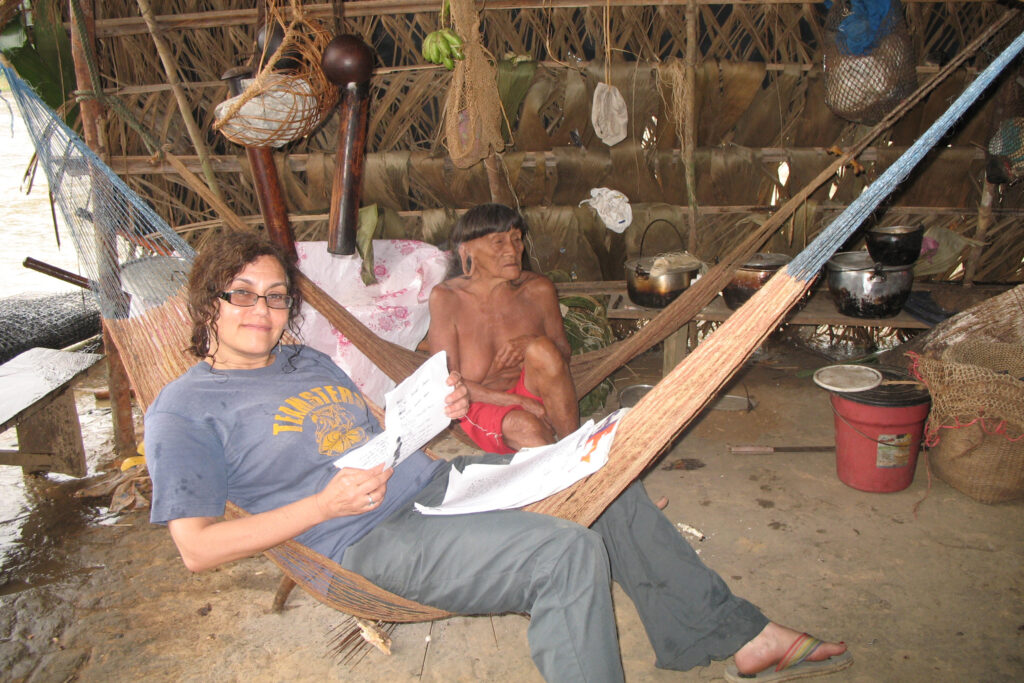
When Kimerling told the Baihuaeri about the Inter-American petition, she explained that the government had a responsibility not only to protect the rights of the uncontacted groups, but the Baihuaeri’s rights, as well.
Armed with that information, the Baihuaeri led a delegation, including Kimerling, to Quito in the summer of 2007, where they told government officials that they, too, lived in the affected region known as the “Intangible Zone,” a conservation area designated on paper by the government in 1999 for the benefit of uncontacted Waorani groups. The Delaware-sized swath of forest, and the six-mile buffer zone surrounding it, are meant to be entirely off limits to all extractive activity. In practice, however, oil operations have expanded into the buffer zone in some places while the environmental impacts of drilling have spilled into the Intangible Zone.
The Baihuaeri’s message to officials was that they also wanted to respect the rights of their uncontacted neighbors—they remembered the trauma of forced contact and did not want the still isolated groups to suffer the same fate. Waorani customary law, like cowode human rights law, recognized uncontacted families’ right to remain uncontacted and they respected that. Officials were initially receptive to the Baihuaeri’s involvement, but later effectively rebuffed their attempts to engage with the government, according to Kimerling.
In 2009, another confrontation with uncontacted people occurred: aislados attacked a group of colonists walking along a new road near a wellsite west of the Intangible Zone.The Baihuaeri had previously warned officials that the area was part of ancestral Tagaeri territory. A subsequent retaliatory attack on an uncontacted group was never officially confirmed, but aislado spears materialized within a colonist town after the incident, a sign that a group of uncontacted people had been killed.
Penti had then told Kimerling that, as long as the forest remains, the aislados will not abandon their ancestral territories—which encompass forest outside the Intangible Zone, and that as long as their territory is being destroyed, they’ll defend it and won’t be at peace.
Cut out from involvement in the government’s plans and without legal title to their ancestral land, the Baihuaeri were left wondering: if all the uncontacted groups are killed, and the Intangible Zone—created for the isolated Waorani groups—no longer has a purpose, then what happens to us, Waorani in recent contact? It seemed like, if something didn’t change, it was only a matter of time before oil operations or displaced aislados came to Bameno, and the Baihuaeri didn’t know if the aislados would come in peace.
“They Do Not Want to Understand”
Kimerling found the invisibility of the Baihuaeri in the myriad of legal actions that affected them to be exasperating. The 2000s had been a banner decade for the legal recognition of the rights of Indigenous peoples, including the 2007 United Nations Declaration on the Rights of Indigenous Peoples. But those ideals were still far from being put into practice.
In 2011, she accompanied a delegation of Baihuaeri to Coca where a meeting between the Ecuadorian Ministry of Environment and their international consultants, representatives of United Nations Educational, Scientific and Cultural Organization (UNESCO), was taking place, regarding the management of Yasuni National Park. Created in 1979, Yasuni was imposed on top of the ancestral territories of Waorani family groups without their consent. For decades oil operations have been ongoing in the park, which is widely considered the most biodiverse place on the planet—a 2.5 acre area of Yasuni contains more species of trees than all of North America combined.
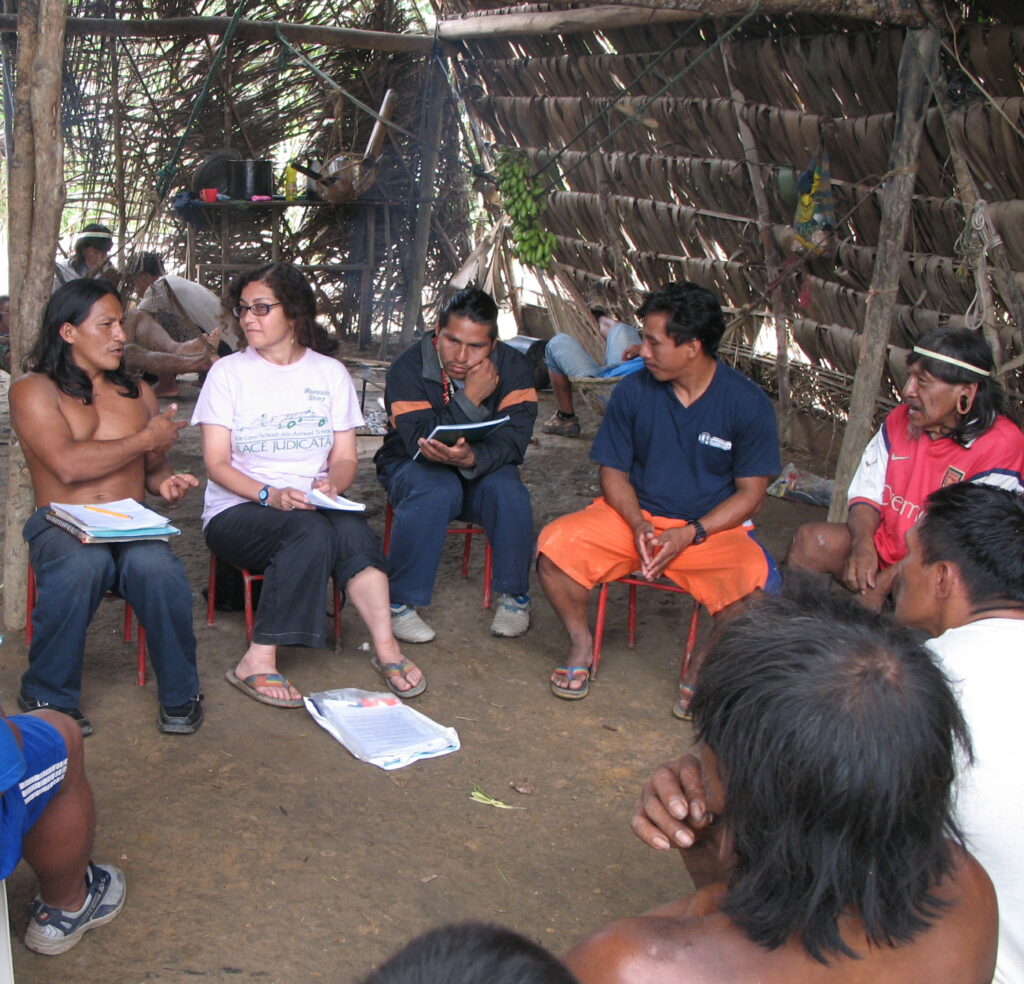
On their way to the meeting, the Baihuaeri told Kimerling that they were hoping to learn about what the government was doing and tell officials how they wanted to live—for the government it was a park but for them it was their ancestral territories. The meeting got off to an inauspicious start when officials tried to remove Kimerling from the meeting, telling her that only Waorani people could attend. Penti and others intervened and eventually Kimerling was allowed to stay, though officials told her she was not allowed to speak.
Kimerling described the meeting as “a box checking exercise where officials sought to create the appearance of a consultation with the Waorani living in Yasuni without any meaningful listening or dialogue.” At one point, Penti told officials that his community wanted title to their ancestral territories. In response, one of the consultants wrote “wants demarcation of the park” on a piece of paper hanging from the wall. Ignoring the gag order placed on her, Kimerling interjected, explaining that what the official wrote wasn’t what Penti had said. An Ecuadorian official pulled Kimerling aside, whispering to her that everyone knows land titles inside national parks are prohibited by the Ecuadorian Constitution. Kimerling asked him to explain that to everyone. The official refused. He also didn’t explain that the Ecuadorian Constitution and international treaties recognize the rights of Indigenous peoples to their ancestral territories and that Ecuador had many conflicting laws on the books.
The officials’ hauteur and mendacity throughout the meeting was not lost on the Waorani participants. Later, they wrote to the U.N. Special Rapporteur on the rights of Indigenous Peoples that it was obvious that U.N. and Ecuadorian officials wanted to use them to be able to say Waorani communities had participated in the official process, but that in reality the officials had no intention of actually engaging with them.
This story is funded by readers like you.
Our nonprofit newsroom provides award-winning climate coverage free of charge and advertising. We rely on donations from readers like you to keep going. Please donate now to support our work.
Donate Now“They do not understand our culture, thinking, concerns or priorities, and what is more, they do not want to understand,” the letter said. “They do not want to engage in a serious dialogue with our communities, instead they seem to think that we are children or animals to manage.”
Kimerling, who later wrote about the incident in detail, found the meeting infuriating. She said she had come to expect oil companies to behave in a “manipulative” way toward Indigenous peoples, but she had hoped that international conservationists would be different.
Convincing powerful entities to respect the concerns and distinct cultures of small communities of people would never be easy. But Kimerling did not expect for things to be this hard.
Another Miscarriage of Justice
In 2011, just as the spring semester began at CUNY, Kimerling received disturbing news.
Chevron had filed a new lawsuit in U.S. federal court against the team of lawyers that had been pursuing the company in the Lago Agrio Court in Ecuador. The complaint alleged that the lawyers and others had violated the civil Racketeer Influenced and Corrupt Organizations (RICO) Act by engaging in fraud and other misconduct ranging from bribery to forgery and ghost writing a key expert report.
Then, thirteen days after Chevron filed its RICO lawsuit, the Lago Agrio court issued an $18 billion judgment against Chevron (later reduced to $9.5 billion) in favor of the Ecuadorian plaintiffs.
The RICO lawsuit cast into doubt the ability of the plaintiffs in the Lago Agrio case to enforce the $9.5 billion judgment, and Kimerling feared the alleged misconduct would open the door for Chevron to try and taint the credibility of the victims’ injuries and block their access to legal remedies. And so, after a series of conversations, more than three dozen Waorani individuals from a handful of communities asked her to take legal action on their behalf.
In November 2012, Kimerling filed a motion to intervene in the RICO case in New York. The judge presiding over the case, Judge Lewis A. Kaplan, rejected the motion, ruling that the Waorani’s interests were adequately protected by the parties in the case—Chevron and the lawyers who had never obtained consent to represent those Waorani in the first place.
Like the ruling dismissing the Texaco lawsuit from U.S. courts, Kimerling saw Kaplan’s ruling as another miscarriage of justice—the Waorani’s rights would be affected by the outcome of the RICO case, but they would not be permitted to speak for themselves. The case allowed Chevron to shift the spotlight to the misconduct of the lawyers, and away from Texaco’s operations. “The legal drama eclipsed the situation on the ground,” Kimerling told me.
She watched the ensuing RICO proceedings from the gallery of the Manhattan federal courthouse, fielding questions from journalists about the case. They asked her why, if Texaco’s damage to the Ecuadorians and the rainforest was so real, the lawyers would engage in such capacious misconduct. It was the same question she had long pondered. “I can’t tell you why the lawyers did what they did,” she answered. “But I can tell you that the harm in Ecuador is very real.”
Conta
In the spring of 2013, Kimerling received word of events from Ecuador that would come to alter the lives of the Baihuaeri and the arc of her work with them.
On March 5, 2013, a group of aislados speared to death two Waorani elders near an oil access road just north of the Intangible Zone. The couple, Ompure and Bugeney, were members of a recently-contacted family group affected by oil operations. No one knew why the aislados had targeted the couple, but one theory was that the isolated group, which had been in contact with Ompure previously, held Ompure responsible for either the recent death of a child or the land invasions of oil companies and others into their territory.
In a reprise attack about three weeks later, relatives of the two elders tracked down an aislado home and murdered 20 to 30 men, women and children. The men spared only two young girls—one named Conta, about 6 or 7, and her younger half-sister, Daboka, about 3. The girls witnessed the attack, including the slaying of their mother, then were taken back to the mens’ communities, known as Dicaro and Yarentaro, to live as members of their families.
The Ecuadorian government responded months later, sending masked men to Yarentaro and forcibly taking Conta and placing her in a hospital guest house in Coca. Penti and his wife, Doboto, had coincidentally been in Coca the day Conta arrived. The officials offered no explanation why they had removed only Conta and not her half-sister, who was living in a different community.
Apparently lacking a plan for what to do with Conta, government officials convened an emergency meeting with Waorani organizations. At the end, officials and Indigenous leaders asked Penti to take custody of Conta. He had concerns that doing so might open the door to the government further asserting itself into the affairs of Bameno. But when he called Kimerling with the news, he told her “the girl has a right to live and she’s innocent.” Despite contact, Bameno’s people had maintained their cultural lifeways and relationship with the forest, and it was remote enough that Conta could live in relative peace. The next day, he met officials and Conta at an airstrip in Coca where they boarded a helicopter and flew over the forest canopy to Bameno.
Kimerling arrived two months later and, in January 2014, met Conta for the first time. By then, she was integrating into her new life, laughing and playing with the other children. But there was no getting around that she had very recently been through an immense amount of trauma.
While Kimerling was in Bameno, members of the Ecuadorian prosecutors’ office visited. The so-called fiscalia had opened a criminal case against seventeen Waorani men accused of killing Conta’s family and wanted to interview Conta and ask Waorani elders what the punishment in their culture would be for this crime. The elders explained that they do not “punish.” “We have times of war and times of peace; the government should help us make peace,” they told the officials.
Still, the government persisted with its criminal prosecution and the interview of Conta. While sitting in the lap of one of Penti’s daughters, she answered some questions but after a few minutes she withdrew and began singing songs that she learned from her Tagaeri family.
Penti stopped the interview.
“Heartbreaking”
Kimerling left Bameno in January 2014 for the start of CUNY’s spring semester. Two months later, Judge Kaplan issued his ruling in Chevron’s RICO lawsuit, declaring that the $9.5 billion Lago Agrio judgment had been procured through fraud and other misconduct, and so could not be enforced within the United States. It was a major blow to any effort to obtain recovery for people affected by Texaco’s Ecuadorian operations.
The word Kimerling uses most often to describe the nearly two decades of litigation over Chevron’s operations is “heartbreaking.” She found much of the evidence Chevron presented of the lawyers’ misconduct to be “compelling,” but said that does not absolve the company for the life-changing harm it caused to the Waorani and others in Ecuador. Kaplan’s ruling coincided with a torrent of adverse developments affecting the Baihuaeri.
The Ecuadorian government, wanting to extract oil in a new region of Yasuni National Park, overlapping with the northeastern section of the Intangible Zone, released a new official map of the area that arbitrarily changed the officially recognized locations of the aislados (Ecuadorian law prohibits drilling on the territories of isolated peoples). In 2014, oil extraction began in the north end of the so-called ITT oil block, the southern part of which includes Baihuaeri and aislado (the Dugakaeri’s) territory.
Then there was how the government dealt with Conta. It refused to acknowledge that she had collective rights as a member of the Baihueri, who had adopted her per Waorani custom, and disregarded her right to be heard, Kimerling said. The ministry of health sporadically sent state affiliated doctors to evaluate her. But instead of seeking to understand and adapt their work to Waorani culture and custom, the doctors seemed to apply the same protocol used for children in Quito or Coca. When officials sent in “care packages” of food for Conta, they sent large packs of sugar and salt—Conta preferred hooks to fish with and live chickens she could eat any time she wanted. And, there was no legal certainty that Conta would be allowed to stay in Bameno. This caused stress and uncertainty for Conta and her Baihuaeri family.
The activists who pursued the Inter-American case also never asked Penti about Conta, Kimerling said. Since neither Conta nor the Baihuaeri were parties to the case, the Commission had no way of knowing about her situation.
Finally, on Sept. 28, 2019, the Inter-American Commission issued its ruling.
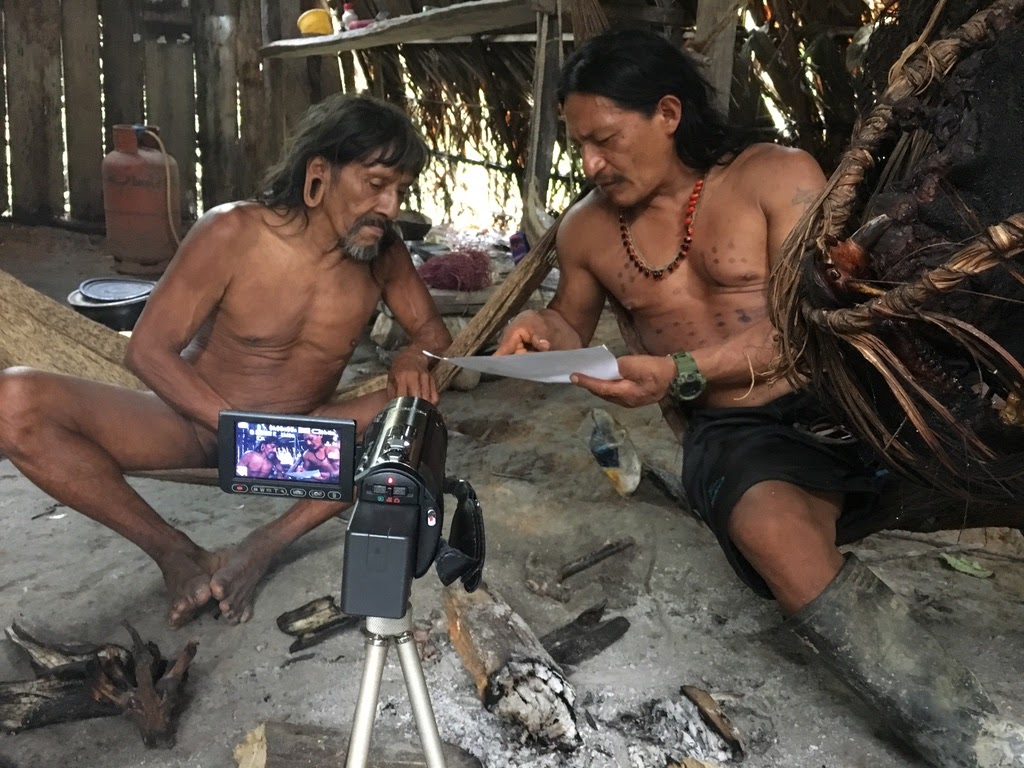
Getting a Seat at the Table
Ecuador had violated the rights of the Tagaeri and Taramonae, the Commission found in its “Merits Report.”
First, the Intangible Zone did not line up with the aislado groups’ territories. Second, Ecuador’s constitution included a backdoor provision, a sort of Damocles sword, over all protected areas that allowed extractive activities to go forward in the Intangible Zone if in the “national interest.” And, among other reasons, the state had failed to protect the isolated groups from violent encounters with third parties, such as in the 2003, 2006 and 2013 massacres.
The Commission issued recommendations including that the Tagaeri and Taromenane be given a land title and for the government to ensure measures are taken to guarantee Conta and her sister Daboka’s well-being. In Kimerling’s reading of the report, there was strong language about the rights of Indigenous peoples living in voluntary isolation—the Commission affirmed their right to remain uncontacted—but she was concerned that the recommendations, if poorly implemented, could give the government license to further interfere with Conta’s life. She also felt the report overlooked that other “rights holders,” meaning the recently contacted Waorani groups—like Penti’s Baihuaeri—lived in and around the Intangible Zone.
The recommendations went unheeded and, in the midst of the Covid-19 pandemic, the commission in September 2020 made a highly consequential move: It referred the case to the Inter-American Court of Human Rights. This set the stage for the first-ever court case involving the rights of Indigenous peoples living in voluntary isolation.
The Inter-American Court of Human Rights is known for its path-breaking jurisprudence on Indigenous land rights and, more recently, human rights and the environment. It was obvious that Conta was a central part of the case, but as it stood after the commission’s referral, she had no means to speak to the court in her own voice.
Penti and Kimerling decided the right thing to do was to tell Conta, who was then about 14 years old, about the case. At the time, Kimerling explained to Conta that her rights were violated when her Tagaeri family was attacked and she was separated from them. Kimerling also told Conta that Indigenous peoples possess a set of collective rights, such as to their shared territory and culture. As a member of the Baihuaeri, who adopted her, Conta shared in their collective rights. She also has individual rights, and those, too, were at issue in the case. Conta’s response was clear: She wanted her voice to be heard.
And so, in the spring of 2021, Kimerling asked the Inter-American Court if Conta could participate in the potentially precedent-setting case. Three months later, the court approved her request, finally giving Conta and the Baihuaeri a seat at the table.
With only two months to prepare an opening brief, Kimerling and Conta spent hours in conversation, with Kimerling writing and repeatedly fact checking the draft brief with Conta, Penti and others. She wrote about Conta’s culture and experience since contact, and wove the history of the region into her brief, wanting the court to understand that the violence at the heart of the case did not occur in isolation, but in the context of oil, forced contact, displacement and loss of territory.
She wrote that in the cowode world, the Waorani were famed for their ferocity, warfare between family groups and defense of their territories with spears. But she pointed out that much less was known about their histories and practices of living well and peacefully, which they described as living in their forest, observing plants and animals, finding trees full of fruit or cotton, storytelling, singing and dancing, being with family, good health and passing along their culture to their children.
Kimerling’s account of Waorani culture and history drew a stark contrast to the government’s portrayal of the cause of the attack on Conta’s family, which officials said resulted from inter-tribal feuding and had nothing to do with oil operations.
In August 2021, Kimerling filed the brief.
They would get their day in court.
The Hearing
At the hearing in Brazil before the Inter-American Court of Human Rights, in August 2022, Kimerling, wearing a black dress and blazer, settled into a swivel chair behind a hardwood counsel’s table. Men and women from across the Americas, wearing a mix of business suits, feathered headdresses and face paint, filled the gallery of the Brasilia courthouse. Kimerling’s co-counsel, the Chilean human rights lawyer Karinna Fernández, sat to Kimerling’s right.
Kimerling paged through the notes she had carefully written out on a white legal pad knowing that the next 10 hours could help determine Conta’s rights and whether the aislados and her Baihuaeri peoples survive, both physically and culturally.
Soon after seven black- and red-cloaked judges filed into the courtroom, a video screen above the dias began playing Conta’s pre-recorded testimony; she had just given birth and could not travel to attend the hearing in person. The camera focused on a teenage girl with long dark hair and almond-shaped eyes. Her skin from temple to temple was painted red with the pulp of the achiote tree, a gesture typically reserved for special events. Conta said it was an expression of happiness and peace. She was seated inside a thatched roof hut, the outline of a hammock made from fibers of a chambira palm tree was visible just over her left shoulder.
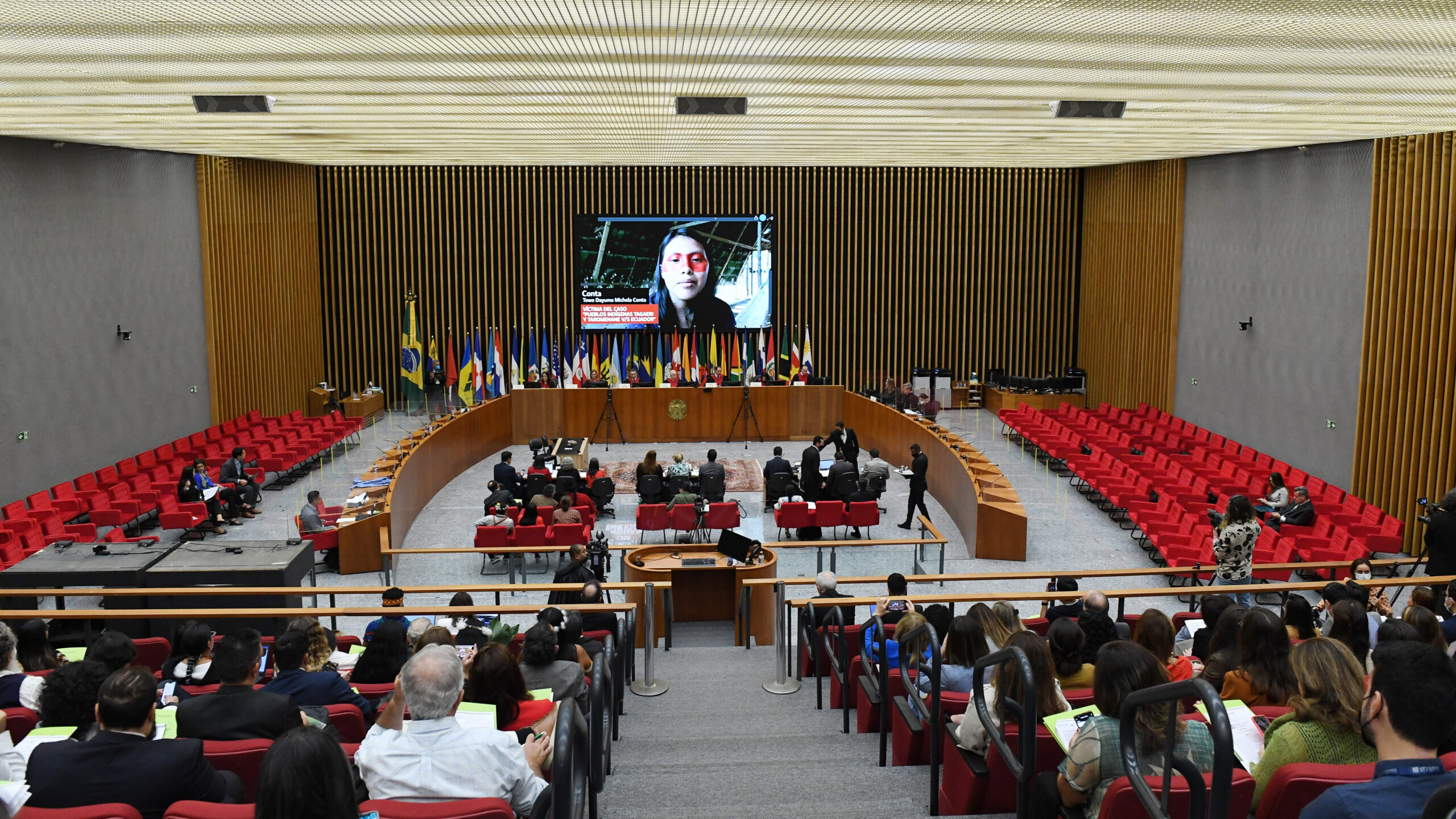
Kimerling’s voice, coming through the video from off screen, led Conta through a line of questioning lasting about 10 minutes. She did not ask Conta to recount the details of the attack on her family—that the attack had occurred was not in dispute. Instead, Kimerling asked how Conta had arrived in Bameno.
Conta said three hooded government officials burst into her schoolhouse in the Yarentaro community and grabbed her from her classroom. “I was crying, where are they taking me…I did not know what world I was in,” she said. “They were taking me to the cowode world.”
She was taken and transported to a hospital in Coca (a place that was entirely foreign to her). There, no one spoke to her in her language about what was happening. She felt completely lost and afraid. After three days, she was taken to the airport and met Penti for the first time. He turned to show her his long Waorani hair and spoke to her in Wao-terero. “I’m Penti,” he told her. “I am Waorani but I am not who killed your family.” They embarked on another government helicopter ride, this time over the blanket of forest that surrounded Bameno and touched down at the small airstrip where members of the Baihuaeri family had gathered to welcome her. “They gave me chicha (a traditional fermented drink made from yucca) because I was hungry.”
That’s when things got better, she explained.
The Baihuaeri took her to the home of Kemperi. He reminded Conta of elders in her Tagaeri family. The Baihuaeri sang, took her to bathe in the river, to plant cassava and plantains, and to fish—all elements of the life Conta had known. “I felt happy,” she recalled and described Bameno as her home and the Baihuaeri as her family.
Then Conta talked about a dream, a significant experience in Waorani culture, where her Tagaeri mother told her “It makes me happy to see that this family has raised you so well.” Conta replied in the dream: “Yes, I’ve been raised well.” The dream took place in her mother’s house and other people present who did not recognize Conta made her feel afraid. She told her mother she had to return to her Baihuaeri family in Bameno.
Kimerling asked one last question: “What do you want from the court, Conta?”
“I want the court to come here, to speak to me in person,” she answered in a soft voice. “I want them to tell the government to let us live, free and with territory, to not destroy the forest.”
Conta’s image, broadcast on the court’s livestream, immediately appeared in tweets and on social media. It was an extraordinary moment, for the court, for Conta and for her Baihuaeri family.
Next, Penti took the witness stand.
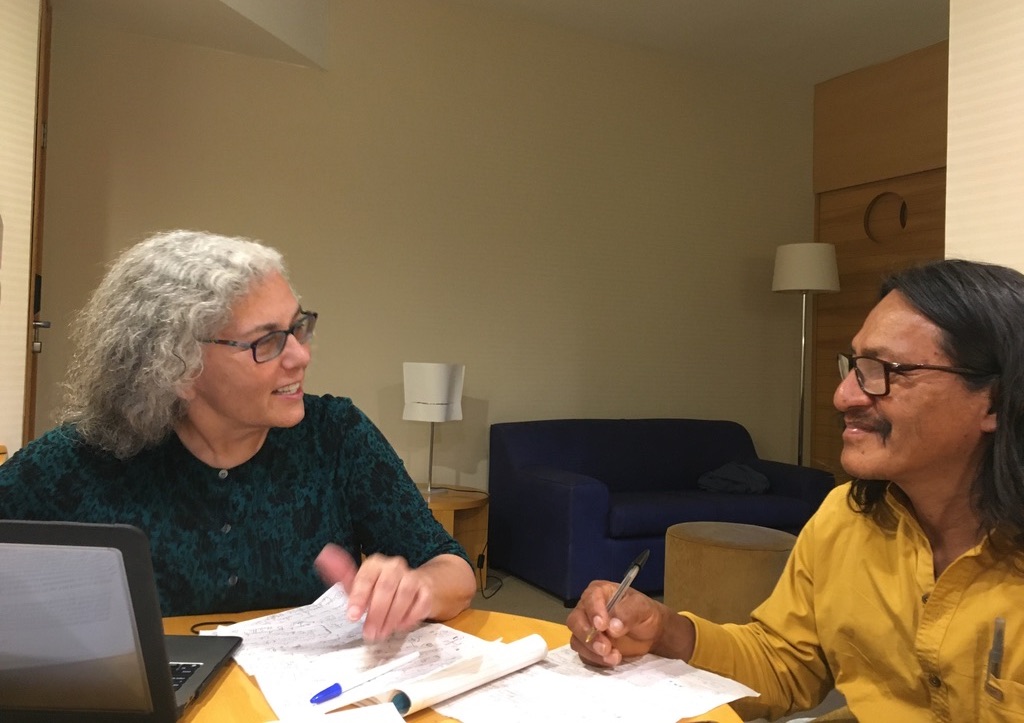
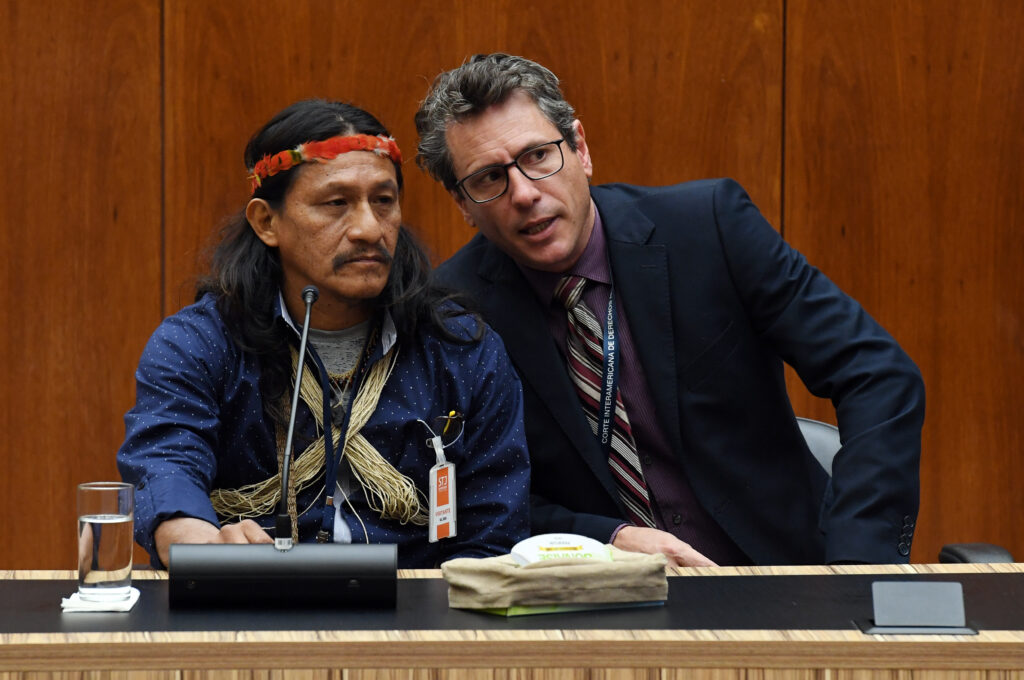
He sat at a table just feet in front of Kimerling, having traveled over 2,000 miles as the only Indigenous witness in person at the hearing.
Wearing a crown of red macaw feathers and a navy collared shirt overlayed with a vest of palm strands, Penti told the judges how the center of the Tagaeri’s ancestral territory was in the heart of where Texaco had operated. Today, that space is one of the most heavily colonized parts of the Ecuadorian Amazon, and the Tagaeri have been pushed southward and eastward into the territories of the Baihuaeri and other Waorani clans. His eyes turned to a screen above the judge’s dias, which showed a photograph of a building with the sign “Auca Central Production Station.”
“What is this photo?” Kimerling asked in Spanish.
“This photo is of Tagaeri ancestral territory,” Penti answered. The production station depicted was one of hundreds of oil wells, waste pits, gas flares and production sites that dot ancestral Waorani territories. Referring to the name of the production station in the photograph, Kimerling next asked Penti what the word “Auca” means.
“Savages,” he said flatly. He said that Auca is a pejorative term used by outsiders to describe the Waorani. Throughout the Ecuadorian Amazon the word is plastered on hotels, roads and restaurants. The American Summer Institute of Linguistics missionaries popularized the smear by designating their campaign to contact the Waorani “Operation Auca.”
Next, Kimerling showed a governmental poster depicting Yasuni National Park, which used images of Penti and other Baihuaeri. Two additional posters by activists to publicize the case misidentified them as Tagaeri and Taromenane. No one had asked their permission for use of their images.
“What do you think when you see these images of you and your family?” Kimelring asked.
“They use our images, but when we ask the government to listen to us, it doesn’t listen…when we claim the right to our territory, it ignores us,” he said.
Later, an employee of Ecuador’s state-run oil company took the stand, asserting that Petroecuador’s Environmental Management Plan controlled for polluting impacts like noxious noise, an agitator of wildlife and the Waorani, who have extremely sensitive hearing. The testimony struck her as similar to what she had encountered during her Occidental research years ago—the company was using the promise of environmental excellence to try to convince the court that expanding oil operations wouldn’t affect the aislados or harm the forest.
But Kimerling, while preparing for the hearing, had studied Petroecuador’s management plan and noticed that the language, which would have been approved by the government, gave the company control over some environmental decision making and monitoring. Like Occidental, Petroecuador was self policing.
With only minutes for cross-examination, Kimerling leaned forward and pulled the microphone closer, asking the witness why Petroecuador’s management plan said “it is suggested” Petroecuador implement noise controls when noise exceeds regulatory limits.
“Who decides whether to comply and why does it not say duty?” she asked, attempting to get at who ultimately controlled decision making. The witness hedged and Kimerling asked a second question: The management plan says there are three alternatives for disposing of contaminated drilling waste and Petroecuador should use the one that is most convenient.
“Convenient for whom?” Kimerling asked pointedly, unintentionally eliciting laughter from people seated in the gallery.
As the hearing wound to a close, Kimerling hoped that the judges would accept Conta’s invitation to speak with her in-person in Bameno and to see the realities of the Ecuadorian oil frontier first hand. Alternatively, they would have to wait for a ruling.
In the meantime, she and the Baihuaeri went back to work.
Gemeneweno 2023
Seven months after the Brasilia hearing, in March 2023, I met up with Kimerling in the Waorani community Gemenoweno, located along the bank of the Shiripuno river on the outskirts of the Intangible Zone.
Members of seven communities had gathered in Gemenoweno to hear about the Inter-American Court case and talk about their concerns. It was why Kimerling was there, and a manifestation of Penti’s vision for how to best defend the forest and their uncontacted neighbors: through dialogue among Waorani communities themselves.
When Penti announced dinner was ready, Kimerling slid next to me at a wooden picnic table and, over our meal of velvety rice, roast chicken and vegetables, told me how important she believed the two-day gathering was going to be. It was part of a process Penti was spearheading to work with communities in Yasuni to protect as much of the forest as possible by agreeing upon a boundary beyond which oil operations could not advance. Kimerling had long ago learned how essential dialogue was to the families she worked with. Decisions were made not by dictate from leaders, but by talking and reaching an agreement.
As critical as the Inter-American Court case was, Kimerling saw this grassroots process as vital. She was happy to sit on the sidelines while it happened and field questions about the court.
“My job isn’t to make decisions for them,” she told me between bites. “It’s to protect them from interference by the government.”
The meeting began around 9:30 p.m. in a high-ceilinged hut a short walk from where dinner had been served. Kimerling took a seat off to the side in a gray canvas folding chair and watched Penti explain in Wao-teroro about the Brasilia hearing, his testimony and how the court’s ruling could affect the lives of the people in the room. It bothered Kimerling that until now, no one had convened a meeting like this for the affected families to learn about the case even though it had been ongoing since 2006.
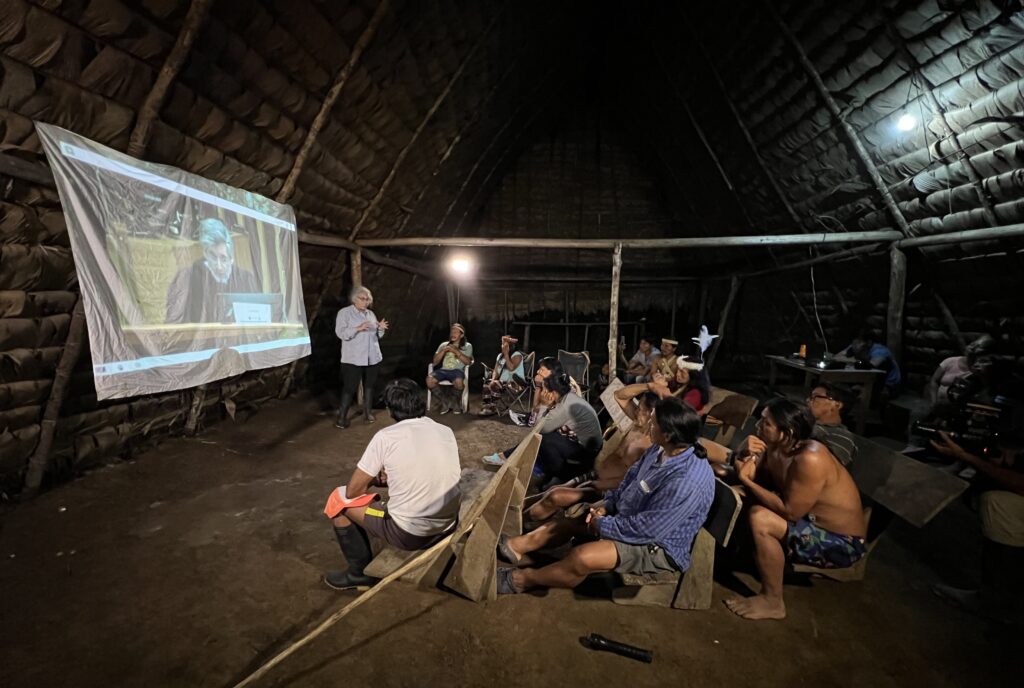
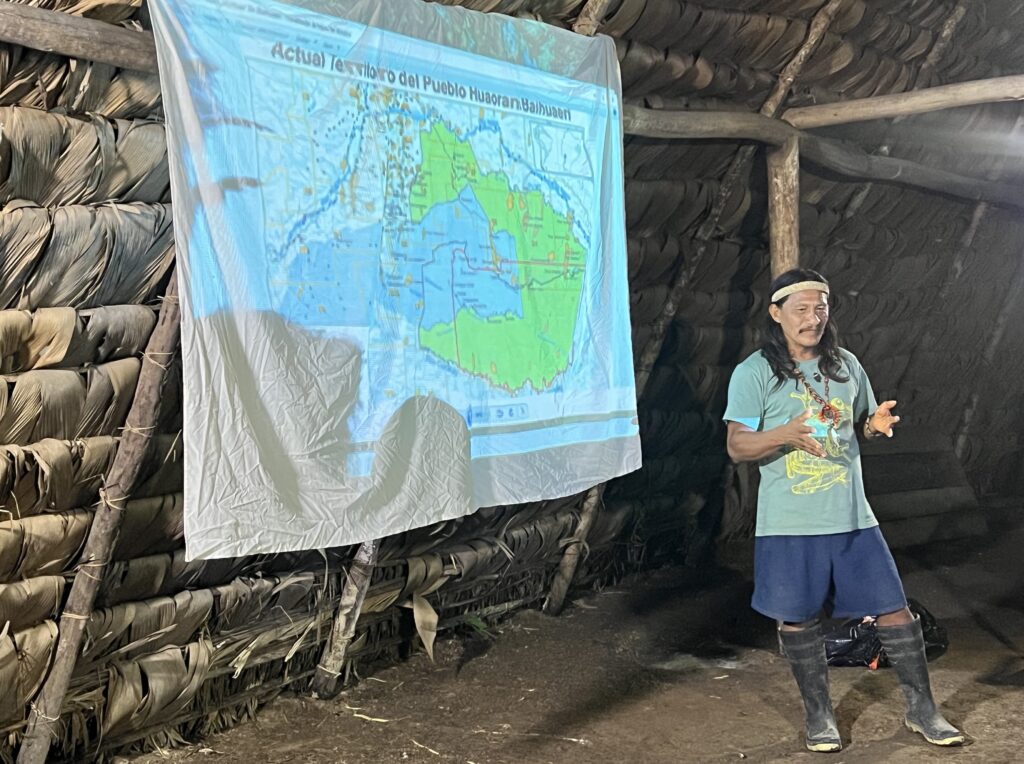
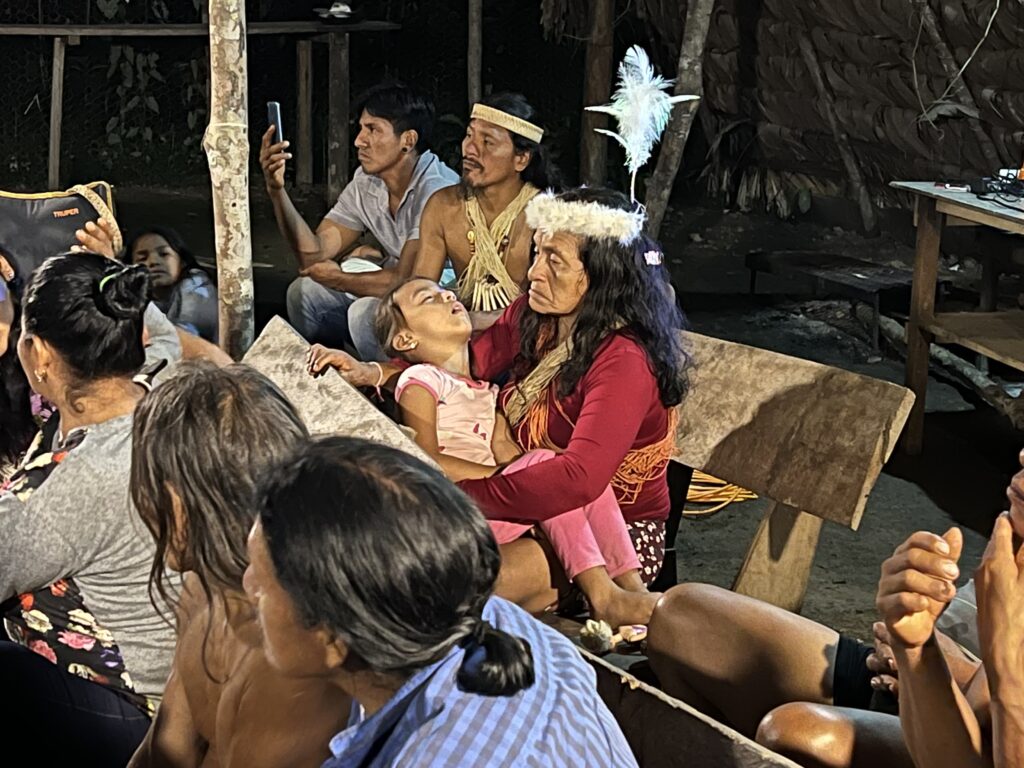
On points like that, when she has felt the Baihuaeri and other groups were being marginalized, Kimerling has been outspoken. As with Robert F. Kennedy Jr. and the lawyers behind the Chevron case, she has, at times, voiced her disagreement not just of the oil industry, but of people seemingly on her side like environmentalists and activists.
For her outspokenness, Kimerling has drawn fire from those groups, and more recently from the Nacionalidad Waorani del Ecuador (NAWE), a Waorani organization, and people aligned with it. NAWE was established in 1991 for the Waorani to engage with the outside world, but after a few years it became dependent on oil companies and the government for funding, according to Kimerling. In 2016, the government transferred to NAWE a land title that had previously recognized some of the territories of the aislados and Baihuaeri. The title, Kimerling said, wrongly claimed that NAWE is an “ancestral” entity and the Waorani “self-determine” as just one people with one sole authority and territory. That development spurred the Baihuaeri to formally separate from the organization.
“NAWE is a cowode thing, it is not Waorani culture,” Huane Ima, an elder from a different family group, said in a supporting affidavit Kimerling had submitted to the court.
Kimerling had argued that putting the land title in NAWE’s name violates the territorial rights of the aislados and Conta because Indigenous peoples have rights to their territories in accordance with their culture and customary law. As she argued, the government was using NAWE’s land title and bylaws to attempt to “impose the organization as the governing authority over all Waorani peoples’ territories” without their consent.
Her defense of the Baihaueri’s resistance to NAWE’s authority has made Kimerling the target of verbal and written attacks from some activists and government officials. When I asked Penti about this, he told me that “Judith is only saying what we taught her.”
Now, Kimerling stood and briefly spoke to the group, in Spanish, about the case and the government’s obligations to protect human rights. Despite the seriousness of the subject matter, it was an uplifting moment for her—she had come to Ecuador in 1989 wanting to work with local communities who wanted to defend their forest. She felt things had come full circle.
As the discussion drew to a close around 11:30, a Waorani woman grabbed Kimerling’s hand, pulling her to join a group chanting and singing about their territory:
Our grandmothers and grandfather lived in this territory;
Where our grandmothers and grandfathers cared for and maintained our territory, we walk in the rainforest and the wind brings us a lovely smell;
The rich scent of enquenta (the Waorani name for a type of flower) makes us feel the life of the rainforest.
Shiripuno River Travel
Early the next morning Kimerling said her goodbyes to the group and to Penti, whispering to him how sad and sorry she was that his uncle Kemperi had passed away two days earlier, but that she was heartened by the news that Penti’s new grandson was born on the same day and would carry on the family lineage. Later, the boy was named Kemperi.
The morning had a somber air, and they continued talking as they walked down to the riverside over a carpet of spongy moss, leaves and wooden planks. A motorista and a few other passengers were waiting alongside a long fiberglass canoe. Unlike my trip here to Gemeneweno, when it had been sheeting rain heavier than I have ever seen it rain, today the sky was cloudy with beams of sunlight poking through.
Now, as our motorista, a Waorani man in a green T-shirt and shorts, maneuvered our boat upstream, the seemingly infinite jungle hung over either side of the river. Turtles basked on logs and rocks protruding from the water. The air smelled of fresh, wet earth, and the rainforest foliage contained every shade of green imaginable. As if on cue, a toucan with an orange, purple and yellow beak did an acrobatic swoop across the water.
To exit the forest, everyone had to pass through the government checkpoint on the bank of the Shirupuno. The flow of people had unintended consequences, sparking growth in the once tranquil area. On Sundays in particular, people gathered near the bridge to drink. Penti warned Kimerling that she should leave early to avoid being harassed. They had also gotten word that the officers at the checkpoint had been asking about Kimerling—when she was coming out of the forest and what she was doing. It seemed her presence still inspired concern among the authorities.
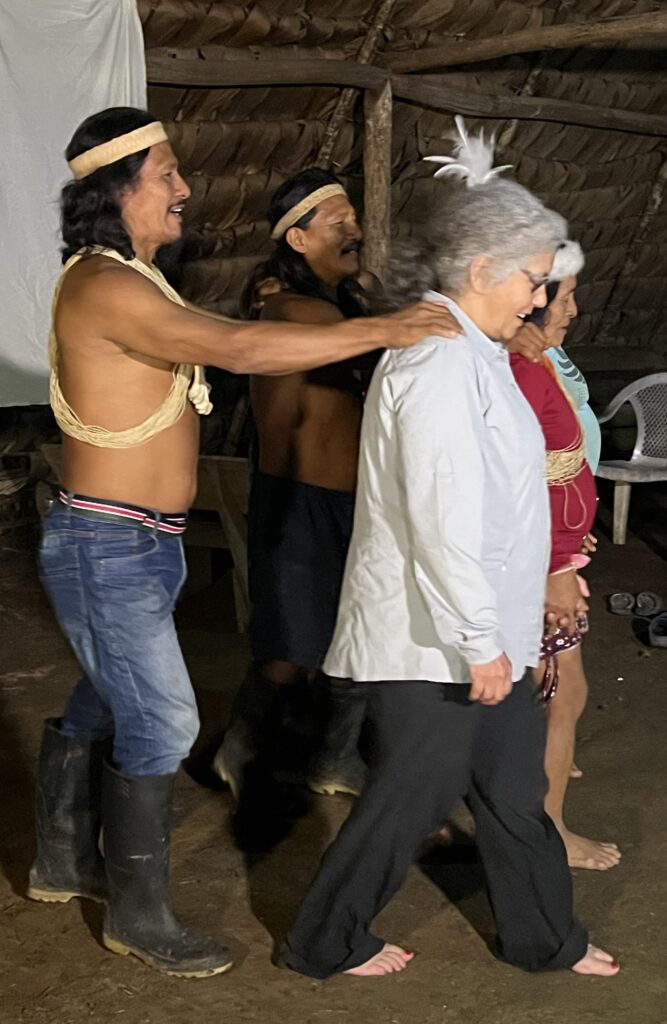
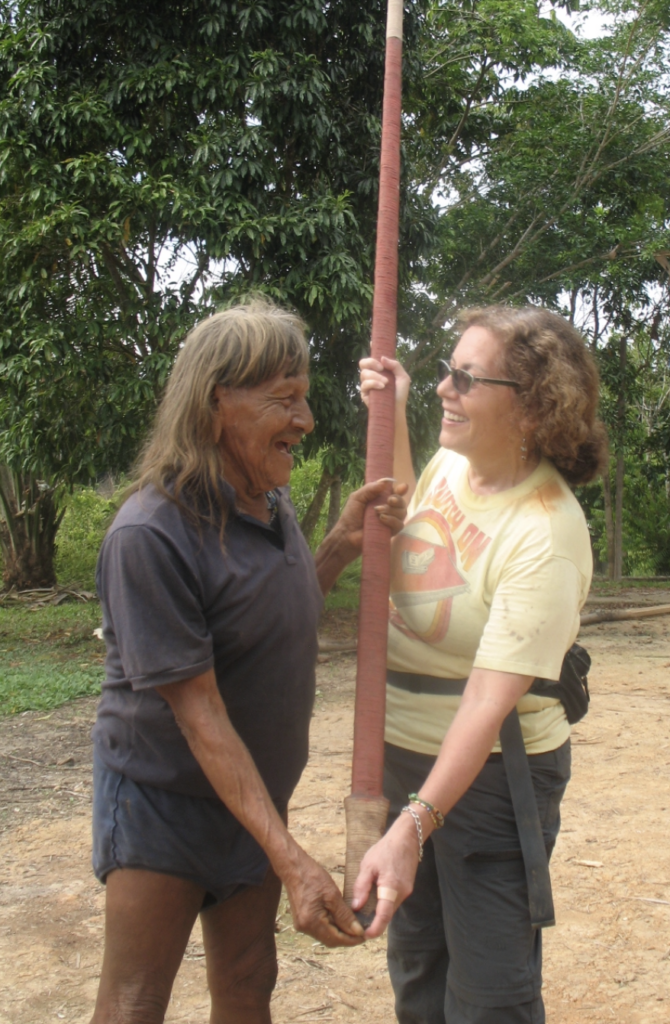
Once we arrived at the checkpoint, waiting for our ride back to Coca, I asked Kimerling how she was feeling about the loss of Kemperi, Penti’s uncle. Kimerling had previously told me that she had a special friendship with the elder, who gave her his sister’s Waorani name in a gesture of familial warmth. She hadn’t yet let herself think too much about it, knowing she had to focus on work. According to Waorani beliefs, his spirit would continue walking in the same forest he walked during his human life and might come to visit when a future shaman emerges. During one of their many conversations over the years, Kimerling had asked him about what would happen if the jaguar went extinct—the cat needs a large territory to survive and like the Waorani has continually lost habitat. Kemperi told her he couldn’t conceive of the jaguar not existing. It simply wasn’t possible for that to happen—all of existence was interconnected.
We piled into a small white truck and took off up a dirt road. Kimerling explained that the road we were on now, the “Via Auca,” had been built by Texaco. She pointed out new clearings and side roads that continued to spring up.
“This was all primary forest belonging to the Tagaeri and Imairi family groups before Texaco came,” she said, pointing out the window at the colonized landscape.
We drove past production stations, gas flares and pipelines. Trucks moving heavy equipment lumbered up hills.

When we reached the town of Dayuma, Kimerling requested we stop at a vendor whom she touted as having the best chicken on a stick. The town, all tightly packed stucco structures, was buzzing with street traffic, pedestrians and skinny dogs looking for scraps of food.
While we waited in line, Kimerling told me the story of Dayuma—the namesake of the town. As a young Waorani woman, Dayuma’s family had been embroiled in violence. Fleeing, she ended up working on a plantation in near slave-like conditions. Rachel Saint, a missionary from Pennsylvania, essentially bought Dayuma’s freedom, Kimerling said, and the two women grew close as Saint evangelized Dayuma and Dayuma taught Saint Wao-terero. In 1958, Dayuma took Saint and another missionary to live with her family in the forest, marking the beginning of the evangelization and pacification of the Waorani, and the process of displacement that is continuing today.
“Now, they have new problems and the Waorani who still live in the forest can’t live tranquilo,” Kimerling said, specifically referring to the Baihuaeri. “Because our world collided into theirs.”
We purchase our $1.00 chicken and plantain on a stick, which Kimerling was right about. It was delicious.
Yepez
I traveled from Coca to Quito with Kimerling, where she let me tag along to a meeting between her and one of her long-time friends. Margarita Yepez, a former Texaco social worker whom Kimerling has known for over 30 years, greeted us outside an indoor shopping center near the Parque Carolina.
Yepez, a petite woman dressed impeccably and with a silvery bob haircut, led us upstairs to the food court where, over fruit and yogurt smoothies, I asked about the first time the two women met.
“I’d already known about you because I heard you were at a restaurant with your friend, Kennedy,” Yepez said, taking a sip of her smoothie. “I thought this American would be tall and blonde, and then I saw this petite person with dark hair and emerald eyes. I thought, no, this can’t be her.”
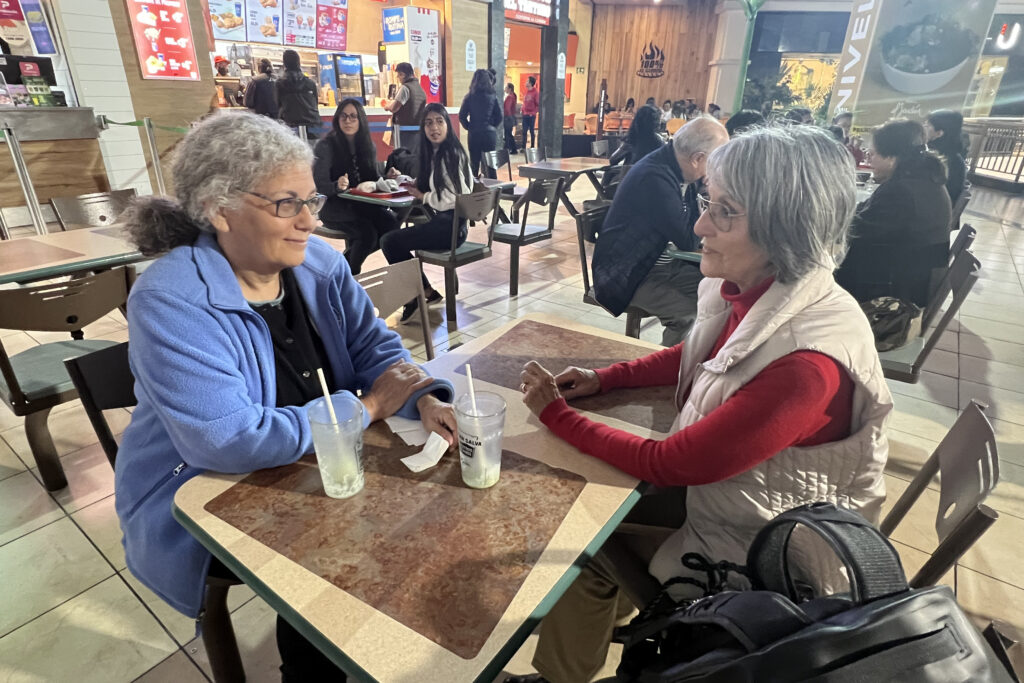
The two became fast friends, with Yepez helping Kimerling find swimming pools to lap swim in while she was living in Quito. But it was the information about Texaco that Yepez shared with Kimerling which she appreciated the most.
“You gave me a lot of information, including a magazine from Texaco that I quoted from in a law review article,” Kimerling said. The magazine was an important source because it gave a contemporaneous account of Texaco’s portrayal of itself as an international company conquering nature. “After Texaco was sued, it painted itself as just a contractor of the state that made no important decisions. That magazine helped me show the two faces of Texaco.”
Amazon Crude, Yepez said, shocked the company’s workers in Quito, who knew nothing of the environmental and human ravaging in the forest. “Journalists said we were stupid for not knowing, but we believed everything Texaco told us—if you were bald, they told us to put oil in our hair and cover it with a cap; if you had arthritis, the gringos said to put crude oil on your elbows.” Yepez shook her head and pursed her lips.
The conversation moved on to more recent developments and Kimerling’s travels.
Yepez said that she’s heard rumors about new environmental licenses for oil companies to operate closer to the Intangible Zone.
“The judges asked about expanding oil operations,” Kimerling said, referring to the hearing in Brasilia. “I’ve heard about expansions in Block 43 and 31, but we don’t have access to official information about it yet. If you hear about anything let me know.”
Kimerling took a sip of her smoothie before continuing.
“You can’t be tired of sending me news reports and information yet.”
New York City Lunch
Union Square Cafe is crowded with a busy throng of brunch goers on this sunny Saturday in May.
It’s been about a month since I parted ways with Kimerling in Ecuador and I easily spot her in the horde of people because she is wearing a chambria palm woven bag slung across her shoulder.
She joins me at a two-person table by the window. Over the course of our lunch—which lasts long after the other patrons have left—it becomes clear that though she is physically here in New York City, her head is still in Ecuador.
It’s possible the court could issue its ruling any day. In the meantime, Penti has continued to convene meetings among Waorani groups to discuss how they can come together to defend their territories and protect the aislados.
It is hard to spend any amount of time with Kimerling and not notice the intensity with which she pursues her work. Mark Cullen, the doctor who helped Kimerling evaluate scientific data in Ecuador, told me he’s never encountered someone with as much dedication to uncovering the truth, emphasizing her capacity to integrate scientific rigor and maintain intellectual honesty. “She’s uncompromising and cares about every single member of the communities she’s interacted with,” he said.
Bonifaz, the lawyer who began the Texaco lawsuit, conveyed a similar sentiment when he told me that, had it not been for Kimerling, he and most of the world would never have known about what Texaco had done. And, Ximena Landazuri, an Ecuadorian anthropologist working with the Baihuareri and Kimerling to document Waorani history and cultural practices, said Kimerling’s counsel about outside laws and processes has been “invaluable” in helping the Baihuaeri navigate the outside world. “I’ve seen the camaraderie and friendship between them,” Landazuri said. “People talk with her about their Waorani lives…she is not like a usual ‘gringa.’”
If Kimerling’s three decades of work in Ecuador have proved anything, it might be what Kimerling realized early on at Yale Law School: that the law is not amoral. The decisions that lawmakers, lawyers, judges and other players in the justice system make are fraught with moral choices. Just as Kimerling resisted some conventions of the legal culture back then, she has continued to forge her own path within the law and advocacy arenas. Doing so has not come without trade-offs or sacrifice, both pecuniary and otherwise. But Kimerling says she has no regrets.
Now, newly retired from CUNY and a professor emerita, she’s still working at full steam. She’s made convincing courts and other institutions of the need to empower local Indigenous people a central axis of her work. Beyond oil and other resource extraction, she’s become increasingly concerned about what she called “internationally funded green climate initiatives” and how they could endanger Indigenous peoples’ rights.
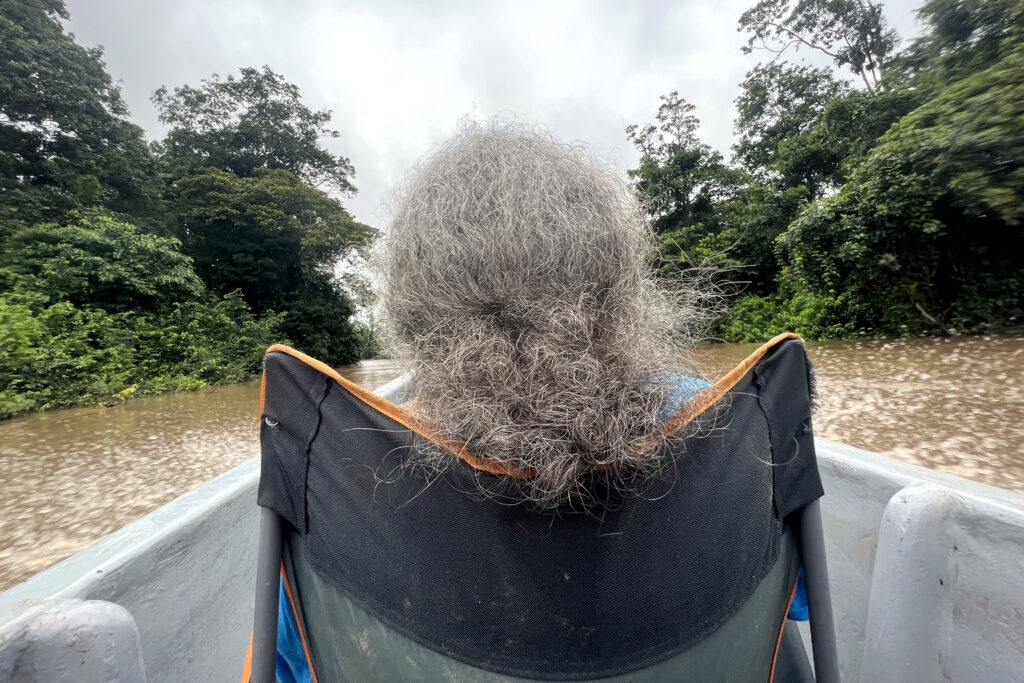
The academic world has, in recent years, caught up with her. Growing research is proving out what Kimerling has long advocated for: The best way to safeguard nature is to give Indigenous communities secure land titles to their territories. This and self determination, Kimerling says, are the keystone to helping the Baihuaeri and other Waorani groups survive into the future. “If you undermine the culture that has preserved the area for millena and change their relationship with their forest, then that’s not good for conservation and it puts people at risk. We need to support and empower communities who want to protect their forest.”
“The Baihuaeri have already lost so much. Penti tells me that something has to remain for them,” she says forcefully. “How much should the Waorani peoples have to sacrifice for people living elsewhere?”
She pauses, and from her seat in this Gramercy Park restaurant, it feels as if she is drawing together all of her years of experience—from Birmingham to Michigan, law school, Love Canal, CUNY and Bameno.
“It’s been 50 years now since the government has said oil will make Ecuador prosperous,” she says. “Who is prosperous? How long will they keep making the same promises to the nation at the expense of the Waorani?”






